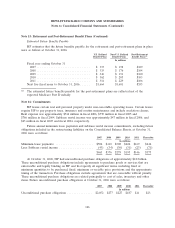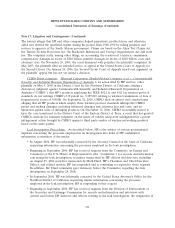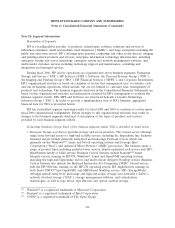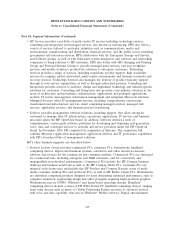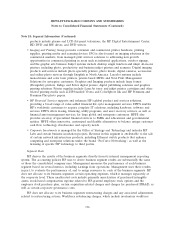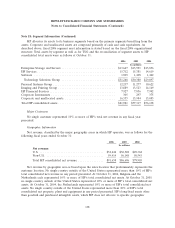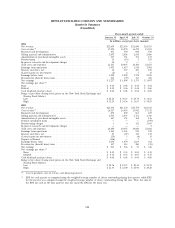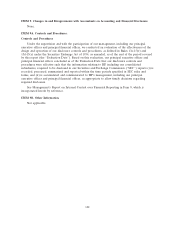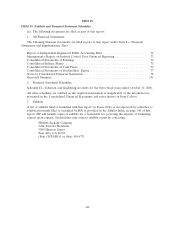HP 2006 Annual Report Download - page 138
Download and view the complete annual report
Please find page 138 of the 2006 HP annual report below. You can navigate through the pages in the report by either clicking on the pages listed below, or by using the keyword search tool below to find specific information within the annual report.
HEWLETT-PACKARD COMPANY AND SUBSIDIARIES
Notes to Consolidated Financial Statements (Continued)
Note 18: Segment Information
Description of Segments
HP is a leading global provider of products, technologies, software, solutions and services to
individual consumers, small and medium sized businesses (‘‘SMBs’’), and large enterprises including the
public and education sectors. HP’s offerings span personal computing and other access devices, imaging
and printing-related products and services, enterprise information technology infrastructure, including
enterprise storage and server technology, enterprise system and network management software, and
multi-vendor customer services including technology support and maintenance, consulting and
integration and managed services.
During fiscal 2006, HP and its operations are organized into seven business segments: Enterprise
Storage and Servers (‘‘ESS’’), HP Services (‘‘HPS’’), Software, the Personal Systems Group (‘‘PSG’’),
the Imaging and Printing Group (‘‘IPG’’), HP Financial Services (‘‘HPFS’’), and Corporate Investments.
HP’s organizational structure is based on a number of factors that management uses to evaluate, view
and run its business operations, which include, but are not limited to, customer base, homogeneity of
products and technology. The business segments disclosed in the Consolidated Financial Statements are
based on this organizational structure and information reviewed by HP’s management to evaluate the
business segment results. ESS, HPS and Software are structured beneath a broader Technology
Solutions Group (‘‘TSG’’). In order to provide a supplementary view of HP’s business, aggregated
financial data for TSG is presented herein.
HP has reclassified segment operating results for fiscal 2005 and 2004 to conform to certain minor
fiscal 2006 organizational realignments. Future changes to this organizational structure may result in
changes to the business segments disclosed. A description of the types of products and services
provided by each business segment follows.
Technology Solutions Group. Each of the business segments within TSG is described in detail below.
•Enterprise Storage and Servers provides storage and server products. The various server offerings
range from low-end servers to high-end scalable servers, including the Superdome line. Industry
standard servers include primarily entry-level and mid-range ProLiant servers, which run
primarily on the Windows(1), Linux and Novell operating systems and leverage Intel
Corporation (‘‘Intel’’) and Advanced Micro Devices (‘‘AMD’’) processors. The business spans a
range of product lines, including pedestal-tower servers, density-optimized rack servers and HP’s
BladeSystem family of blade servers. Business Critical Systems include Itanium(2)-based
Integrity servers running on HP-UX, Windows, Linux and OpenVMS operating systems,
including the high-end Superdome servers and fault-tolerant Integrity NonStop servers. Business
Critical Systems also include the Reduced Instruction Set Computing (‘‘RISC’’)-based servers
with the HP 9000 line running on the HP-UX operating system, HP AlphaServers running on
both Tru64 UNIX(3)and OpenVMS, and MIPs-based NonStop servers. HP’s StorageWorks
offerings include entry-level, mid-range and high-end arrays, storage area networks (‘‘SANs’’),
network attached storage (‘‘NAS’’), storage management software, and virtualization
technologies, as well as tape drives, tape libraries and optical archival storage.
(1) Windows is a registered trademark of Microsoft Corporation.
(2) Itanium is a registered trademark of Intel Corporation.
(3) UNIX is a registered trademark of The Open Group.
134




